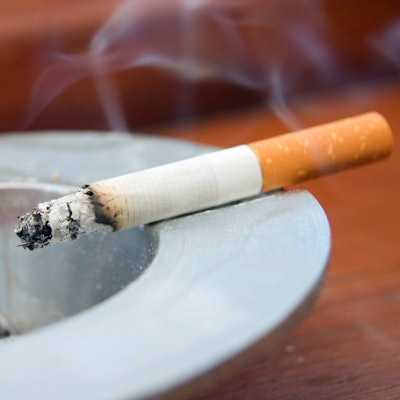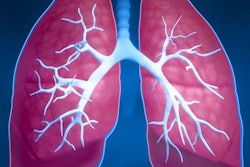
If you restricted CT lung cancer screening to patients at higher risk of lung cancer, could you save lives while reducing the harms of screening? That's the suggestion of a study published January 22 in JAMA Internal Medicine. But supporters of CT screening say the proposal has risks of its own -- such as missed cancers.
The new study offers another look at data from a CT lung screening demonstration project performed within the U.S. Veterans Affairs (VA) health system. The project saw a very high rate of false positives -- more than half of all patients -- leading researchers to investigate more-restrictive criteria for determining who should get scanned.
They discovered that the initial CT screens were least effective for patients in the lowest risk category and most effective for those with the highest risk of lung cancer. They suggested that the findings could shape how CT lung cancer screening programs are set up (JAMA Intern Med, January 22, 2018).
"These real-world findings reinforce the need to risk-stratify patients for lung cancer screening and provide support for personalized, risk-based harm-benefit estimates for all eligible persons during lung cancer screening decision-making," wrote first author Dr. Tanner Caverly from the University of Michigan and colleagues.
To screen or not to screen
The debate over the proper implementation of CT lung cancer screening has been ongoing. On the one hand, large-scale studies such as the National Lung Screening Trial (NLST) have shown that CT lung cancer screening reduces mortality by as much as 20%. In addition, the Continuous Observation of Smoking Subjects (COSMOS) trial demonstrated that the cumulative benefits of screening outweighed the potential threat of radiation exposure.
On the other hand, critics have raised the same questions about CT lung screening that have been raised about breast screening -- namely, that the benefits of screening should be weighed against potential harms such as false positives and radiation exposure. Other concerns include screening's added cost, low participation rate, and nuanced implementation, which could complicate matters further and continue to limit its real-world application.
"As far as the U.S. national implementation of lung cancer screening goes, we are in our infancy," Dr. Ella Kazerooni, chair of the American College of Radiology's (ACR) Lung Cancer Screening Committee, told AuntMinnie.com in response to the current study. "The number of screening sites coming online is growing quickly, but we are a long way from a nationwide task of screening all those who are at risk."
Various proposals to boost the viability of lung cancer screening by researchers from around the world have emerged in recent years. Some have suggested that more-stringent screening criteria may improve cost-effectiveness. Also, researchers from Canada developed the Pan-Canadian Early Detection of Lung Cancer (PanCan) risk prediction model, which increased screening efficiency to a statistically significant degree compared with the current U.S. Preventive Services Task Force (USPSTF) recommendations. (The USPSTF screening guidelines are scheduled for an update in 2018.)
Risk stratification criteria
In this new research, Caverly and colleagues re-examined data from the VA CT lung cancer screening demonstration project to determine how the application of risk stratification criteria might influence screening. The original project included data from more than 2,000 patients who met the NLST criteria and underwent an initial screening with CT. Results from that study were published January 2017 in JAMA Internal Medicine, with one of the more surprising findings being a 57% false-positive rate.
With the new study, the researchers wanted to see if they could improve upon that performance. Instead of using NLST criteria, they performed a new data analysis in which patients were selected for screening based on the Bach model, which calculates the one-year cumulative risk of lung cancer based on a patient's age, sex, smoking status, years since quitting smoking, and average number of cigarettes smoked per day while smoking. Caverly and colleagues then calculated the absolute risk reduction in mortality of each patient using the 20% relative risk reduction reported in the NLST; they categorized the patients into five groups (quintiles) based on these values.
After analyzing these data, the researchers found that the patients in the higher quintiles, who had a higher risk of lung cancer, had more lung cancers diagnosed than those who had a lower risk of lung cancer.
| CT lung cancer screening in low- and high-risk patients | ||
| Lower mortality risk (quintile 1) | Higher mortality risk (quintile 5) | |
| No. of lung cancers diagnosed per 1,000 persons screened | 4.8 | 29.7 |
| No. of lung cancer deaths predicted | 0.45 | 3.16 |
| No. of lung cancer deaths prevented | 0.09 | 0.63 |
| No. needed to screen per lung cancer death prevented | 6,903 | 687 |
| Rate of false positives | 53.1%-62.6% | 51.9%-61.5% |
| Rate of false positives requiring follow-up exams | 2% | 2% |
Further analysis showed that in lower-risk quintiles there was a higher rate of false positives discovered for every lung cancer death prevented, compared with the higher quintiles. Quintile 1, for example, included 2,749 false positives per death prevented, whereas quintile 5 had 363 false positives per death prevented (p < 0.05).
This trend suggests that patients with the highest risk of lung cancer based on the Bach criteria had a better harm-to-benefit ratio than patients with a lower risk, according to the authors. However, risk stratification did not alter the rate of false positives, which consistently stayed high throughout all quintiles. Of note, only a low percentage of these false positives required downstream diagnostic evaluation.
"Unfortunately, the use of [low-dose CT] screening even in the highest-risk quintiles is still associated with alarmingly high rates of false-positive results," wrote Dr. Rita Redberg from the University of California, San Francisco (UCSF) in an accompanying editorial.
Reasonable but flawed
Some radiologists have questioned the reliability of applying the Bach risk model in this way: Using the Bach model for lung cancer mortality risk estimations is "reasonably accurate but flawed," Dr. Frederic Grannis from the City of Hope Helford Clinical Research Hospital in Duarte, CA, told AuntMinnie.com.
It gives individuals with a markedly increased risk of lung cancer low estimates when compared with results obtained using other models, such as the lung cancer risk calculator on the Memorial Sloan Kettering Cancer Center website or the Tammemagi risk prediction tool, he said. Reducing estimates of a patient's cancer risk as the Bach model does would lead to less coverage by insurers, fewer patients screened, and a greater mortality rate of people diagnosed outside of screening, Grannis believes.
To be specific, Caverly and colleagues determined the number of patients needed to screen in order to prevent a death (NNS) using the 20% reduction in mortality recorded in the NLST, he said. But a more accurate calculation of NNS would lower these results fourfold, when taking into account the International Early Lung Cancer Action Program (I-ELCAP) finding that 80% of patients who have a lung cancer detected by CT screening can be cured.
"Using a 20% figure is inaccurate in the context of the population," he said. "This percentage represents the lowest possible benefit -- a floor, not a ceiling -- since the NLST had to be concluded early, once a 20% mortality reduction was achieved."
Along those lines, Caverly's group pointed to a major limitation of the research: the use of now-outdated nodule size guidelines for the VA study. This may have contributed to the higher false-positive rate of 58.2% in this study, compared with 26.3% in the NLST.
To compound this limitation, the VA population itself may have been more susceptible to developing lung nodules, Kazerooni noted. Research has shown that high-risk populations yield a different cancer profile than screening with CT in communities that have better access to healthcare resources.
"The VA community has arguably one of the highest cancer risks of any population in the U.S.," Kazerooni said. "Veterans, by employment, are exposed to numerous factors -- such as the high levels of sand and dust in the Middle East -- that could impact the false-positive rate."
Fortunately, "newer nodule management guidelines are showing great promise in lowering false-positive rates," the authors wrote. "Reducing the rate of false-positive findings would improve the harm-to-benefit balance for all quintiles."
More work needed
By restricting criteria for CT lung cancer screening, as the Bach model does, policymakers might be straddling a fine line -- potentially risking patients' lives to reduce costs, according to Grannis.
"On one side, there is terrible suffering and death from lung cancer, and on the other side is a CT scan in three months" to follow up something suspicious, he said. "How many CT scans would outweigh a death from lung cancer?"
Whether they're for or against screening, researchers and public policy experts tend to agree that more work is needed to continue fine-tuning CT lung screening guidelines and improving patient safety through the early detection of lung cancer.
"The future of [lung cancer screening] depends on our ability to re-examine and refine our approach to patient selection and clearly communicate risks and benefits of screening," Redberg wrote.
To that end, improving upon the concept of risk stratification, demonstrated in the study by Caverly's group, may be one way to bolster CT lung cancer screening and the feasibility of its large-scale implementation.
"I support moving in that direction [toward individual patient risk assessment], but I don't think we have all of the information necessary to implement this on a national scale at this time," Kazerooni said. "It's challenging, even today, to get accurate pack-years, let alone collect all of the other factors. What risk calculators do we use? What factors are most relevant? Which is the right risk model, and why? These are questions we need to understand before we move in that direction."



















